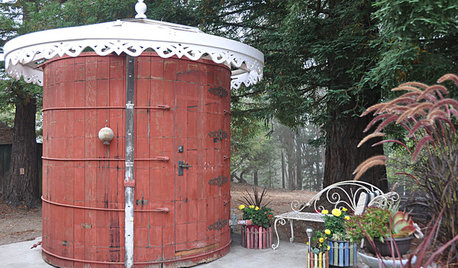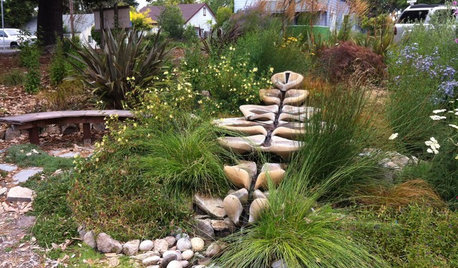Water-tank ('box') design for gravity-feed water system - HELP
joel_bc
16 years ago
Related Stories

OUTBUILDINGSSee an Outdoor Bathroom Made From a Water Tank
This repurposed fixture in a California backyard is now the owners' favorite bathing spot
Full Story
SAVING WATERXeriscape Gardens: How to Get a Beautiful Landscape With Less Water
Conserve water and make gardening much easier with the xeriscape approach’s 7 principles
Full Story
HEALTHY HOMEHow to Choose a Home Water Filtering System
Learn which water purification method is best for your house, from pitchers to whole-house setups
Full Story
EARTH DAYGrow a Beautiful Garden With Ecofriendly Greywater
Reducing home water waste means lower bills and a healthier planet. Here's how to set up a greywater home irrigation system that can help
Full Story
GREEN DECORATINGEasy Green: Big and Small Ways to Be More Water-Wise at Home
These 20 tips can help us all make the best use of a precious resource. How do you save water in summer?
Full Story
GREEN BUILDINGJust Add Water: Rain Barrel Magic
Take your rainwater storage from practical to beautiful with a new breed of design-friendly rain barrels
Full Story
LANDSCAPE DESIGNNew Ways to Design With Water
Go beyond 3-tiered fountains and faux waterfalls to discover water's architectural possibilities
Full Story
GARDENING GUIDESGreat Design Plant: Feed Wildlife With Flowering Currant
Blossoms and berries make this plant irresistible to birds, bees and other critters — and a treat for the eyes too
Full Story
LANDSCAPE DESIGNHow to Move Water Through Your Landscape
Swales, underground pipes or a mix of both: There’s more than one way to distribute water in the garden
Full Story
LANDSCAPE DESIGNGet Along With Less Lawn — Ideas to Save Water and Effort
Ditch the mower and lower your water bill while creating a feast for the eyes with diverse plantings and gathering places
Full Story





jaybc
joel_bcOriginal Author
Related Professionals
Maple Valley Landscape Architects & Landscape Designers · Finneytown Landscape Architects & Landscape Designers · Brownsville Landscape Contractors · Kahului Landscape Contractors · Mahwah Landscape Contractors · Mendota Heights Landscape Contractors · Panama City Beach Landscape Contractors · Weslaco Landscape Contractors · Irvington Landscape Contractors · East Norriton Landscape Contractors · Beverly Hills Siding & Exteriors · Destin Siding & Exteriors · Lebanon Siding & Exteriors · Lombard Siding & Exteriors · South Windsor Siding & Exteriorsjaybc
joel_bcOriginal Author
fruithack
joel_bcOriginal Author
fruithack
Pamchesbay